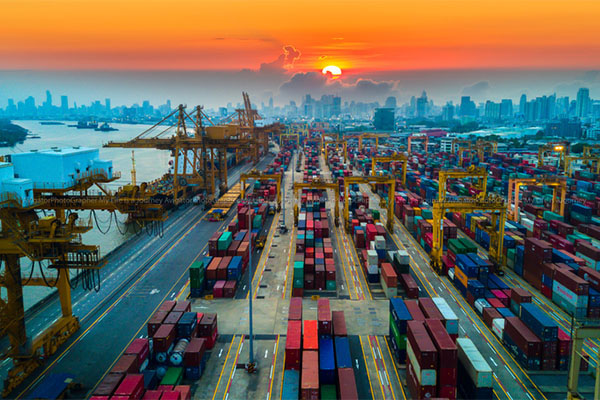Resilience360 report outlines risks to Gulf ports
A better understanding of key supply chain chokepoints will help to assess the potential impact upcoming storms may have on business operations, including their risks to individual shipments, products, facilities, and revenue.

With the passage of Category 4 Hurricane Laura on August 27, Texas and Louisiana crude oil refineries and ports are currently assessing potential damages caused by the storm system and deciding when to begin reopening.
“As hurricane season in the Atlantic basin is currently at its peak, companies with operations along the country’s Atlantic coast are advised to map and visualize the key locations in their supply chain network to gain a comprehensive overview of where they operate, source from, and which transportation hubs are frequently used,” said Antonio Hickman-Diaz, risk intelligence analyst at Resilience360.
He told LM that a better understanding of key supply chain chokepoints will help to assess the potential impact upcoming storms may have on business operations, including their risks to individual shipments, products, facilities, and revenue.
“More than 2.3 million b/d of refining capacity was taken offline ahead of Laura’s arrival. The storm path went directly over two large oil refineries operated by Citgo Petroleum and Phillips 66 near Lake Charles, Louisiana,” he added.
The two refineries closed in preparation for the storm along with five other major oil refineries on the Texas side of the state line. Reports indicate that all five of the refineries are likely to restart operations following safety inspections and once power has been restored in the state.
According to Citgo officials at the Lake Charles location, the company assembled a team to assess the refinery, service providers, and port facilities.
Additionally, the four major refineries in Port Arthur and Beaumont operated by Motiva, ExxonMobil, Total, and Valero Energy, as well as Chevron’s Pasadena Refinery near Houston, closed in preparation for the storm. Safety inspections are ongoing at these facilities and operations are likely to restart once inspections are passed and power is restored.
The nation’s largest refinery, Motiva’s Port Arthur facility, which processes approximately 630,000 b/d, and its terminals sustained minor damages. The company said it will conduct all necessary assessments and preparations to ready its Port Arthur refinery and chemical plant to continue operations as soon as it is safe to do so. Chevron’s Pasadena Refinery has reportedly completed the post-Laura assessment of its facilities, which did not sustain any damage during the storm and has not experienced disruptions to customer’s supply needs.
Although most refineries reported minor damages to their facilities, the storm caused a fire and chemical leak at the BioLab chemical manufacturing facility in Westlake, Louisiana. BioLab manufactures trichloroisocyanuric acid, chlorinating granules, and other home cleaning chemicals including bleach scrub and pool chlorine powder. The company is a subsidiary of KIK Custom Products Inc., a major manufacturer of consumer pool, automotive, and household products.
The fire caused Interstate-10 to close between the cities of Sulphur and Westlake and residents were instructed to close doors and windows. Residual disruptions to other manufacturing operations in the area are likely. A hazmat unit had been called to the plant for a reportedly massive chlorine leak. The incident reportedly broke out only hours after the passage of Hurricane Laura.
Although refineries are undergoing swift safety inspections, storm damages and power outages were widespread throughout the Lake Charles region, so refinery closures may prolong for several days.

Article Topics
Ports News & Resources
Port Tracker report is bullish on import growth over the balance of 2024 U.S.-bound import growth track remains promising, notes Port Tracker report Q&A: Port of Oakland Maritime Director Bryan Brandes Signs of progress are being made towards moving cargo in and out of Baltimore New Breakthrough ‘State of Transportation’ report cites various challenges for shippers and carriers in 2024 Industry experts examine the impact of Baltimore bridge collapse on supply chains Port of Baltimore closed indefinitely to ships after 1.6-mile Key Bridge collapses following maritime accident More PortsLatest in Logistics
Port Tracker report is bullish on import growth over the balance of 2024 Varying opinions on the tracks regarding STB’s adopted reciprocal switching rule National diesel average falls for the fourth consecutive week, reports EIA New Descartes’ study examines consumer preferences, changes, and shifts in e-commerce home delivery preferences Potential Canadian rail strike could damage the country’s economy C.H. Robinson highlights progress of its AI-focused offerings with a focus on automating shipping processes UPS announces CFO Newman to leave company, effective June 1 More LogisticsAbout the Author
Subscribe to Logistics Management Magazine

Find out what the world's most innovative companies are doing to improve productivity in their plants and distribution centers.
Start your FREE subscription today.
May 2024 Logistics Management

Latest Resources














